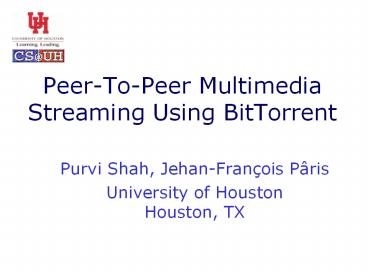Peer-To-Peer%20Multimedia%20Streaming%20Using%20BitTorrent PowerPoint PPT Presentation
Title: Peer-To-Peer%20Multimedia%20Streaming%20Using%20BitTorrent
1
Peer-To-Peer Multimedia Streaming Using BitTorrent
- Purvi Shah, Jehan-François Pâris
- University of HoustonHouston, TX
2
Problem Definition
One Server
Transferring videos is a resource intensive task!
ManyCustomers
- Objectives
- Customer satisfactionMinimize customer waiting
time - Cost effectivenessReduce operational costs
(mostly hardware costs)
3
Transferring Videos
- Video download
- Just like any other file
- Simplest case file downloaded using conventional
protocol - Playback does not overlap with the transfer
- Video streaming from a server
- Playback of video starts while video is
downloaded - No need to wait until download is completed
- New challenge ensuring on-time delivery of data
- Otherwise the client cannot keep playing the video
4
Why use P2P Architecture?
- Infrastructure-based approach(e.g. Akamai)
- Most commonly used
- Client-server architecture
- Expensive Huge server farms
- Best effort delivery
- Client upload capacity completely unutilized
- Not suitable for flash crowds
5
Why use P2P Architecture?
- IP Multicast
- Highly efficient bandwidth usage
- Several drawbacks so far
- Infrastructure level changes make most
administrators reluctant to provide it - Security flaws
- No effective widely accepted transport protocol
on IP multicast layer
6
P2P Architecture
- Leverage power of P2P networks
- Multiple solutions are possible
- Tree based structured overlay networks
- Leaf clients bandwidth unutilized
- Less reliable
- Complex overlay construction
- Content bottlenecks
- Fairness issues
7
Our Solution
- Mesh based unstructured overlay
- Based on widely-used BitTorrent content
distribution protocol - A P2P protocol started 2002
- Linux distributors such as Lindows offer software
updates via BT - Blizzard uses BT to distribute game patches
- Start to distribute films through BT this year
8
(No Transcript)
9
BitTorrent (I)
10
BitTorrent (II)
- Has a central tracker
- Keeps information on peers
- Responds to requests for that information
- Service subscription
- Built-in incentives Rechoking
- Give preference to cooperative peers Tit-for-tat
exchange of content chunks - Random search Optimistic un-choke
- When all chunks are downloaded, peers can
reconstruct the whole file - Not tailored to streaming applications
11
Evaluation Methodology
- Simulation-based
- Answers depend on many parameters
- Hard to control in measurements or to model
- Java based discrete-event simulator
- Models queuing delay and transmission delay
- Remains faithful to BT specifications
12
BT Limitations
- BT does not account for thereal-time needs of
streaming applications - Chunk selection
- Peers do not download chunks in sequence
- Neighbor selection
- Incentive mechanism makes too many peers to wait
for too long before joining the swarm
13
Chunk Selection Policy
- Replace BT rarest first policy by a sliding
window policy - Forward moving window is equal to viewing delay
chunk not yet received
Download window
missed chunk
received chunk
playback start
playback delay
14
Two Options
- Sequential policy
- Peers download first the chunks at the beginning
of the window - Limit the opportunity to exchange chunks between
the peers - Rarest-first policy
- Peers download first the chunks within the window
that are least replicated among its neighbors - Feasibility of swarming by diversifying available
chunks among peers
15
Best
Worst
16
(No Transcript)
17
Discussion
- Switching to a sliding window policy greatly
increases quality of service - Must use a rarest first inside window policy
- Change does not suffice to achieve a satisfactory
quality of service
18
Neighbor Selection Policy
- BT tit-for-tat policy
- Peers select other peers according to their
observed behaviors - Significant number of peers suffer from slow
start - Randomized tit-for-tat policy
- At the beginning of every playback each peer
selects neighbors at random - Rapid diffusion of new chunks among peers
- Gives more free tries to a larger number of peers
in the swarm to download chunks
19
(No Transcript)
20
(No Transcript)
21
Discussion
- Should combine our neighbor selection policy
with our sliding window chunk selection policy - Can then achieve an excellent QoS with playback
delays as short as 30 s as long as video
consumption rate does not exceed 60 of network
link bandwidth.
22
Comparison withClient-Server Solutions
23
Chunk size selection
- Small chunks
- Result in faster chunk downloads
- Occasion more processing overhead
- Larger chunks
- Cause slow starts for every sliding window
- Our simulations indicate that 256KB is a good
compromise
24
(No Transcript)
25
Premature Departures
- Peer departures before the end of the session
- Can be voluntary or resulting from network
failures - When a peer leaves the swarm, it tears down
connections to its neighbors - Each of its neighbors to lose one of their active
connections
26
- Can tolerate the loss ofat least 60 of the
peers
27
Future Work
- Current work
- On-demand streaming
- Robustness
- Detect malicious and selfish peers
- Incorporate a trust management system into the
protocol - Performance evaluation
- Conduct a comparison study
28
Thank You Questions?
- Contact purvi_at_cs.uh.edu
- paris_at_cs.uh.edu
29
Extra slides
30
nVoD
- Dynamics of client participations, i.e. churn
- Clients do no synchronize their viewing times
- Serve many peers even if they arrive according to
different patterns
31
Admission control policy (I)
- Determine if a new peer request can be accepted
without violating the QoS requirements of the
existing customers - Based on server oriented staggered broadcast
scheme - Combine P2P streaming and staggered broadcasting
ensures high QoS - Beneficial for popular videos
32
Admission control policy (II)
- Use tracker to batch clients arriving close in
time form a session - Closeness is determined by threshold ?
- Service latency, though server oriented, is
independent of number of clients - Can handle flash crowds
- Dedicate ? channels for each video making worst
service latency, w ? D/?
33
Results
- We use the M/D/? queuing model to estimate the
effect on the playback delay experienced by the
peers

